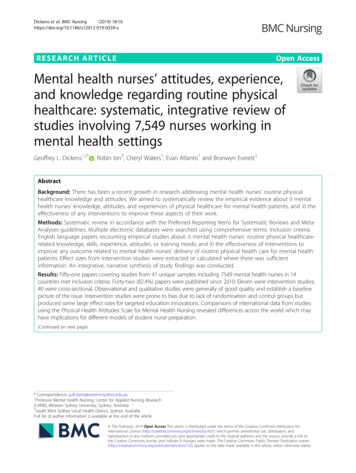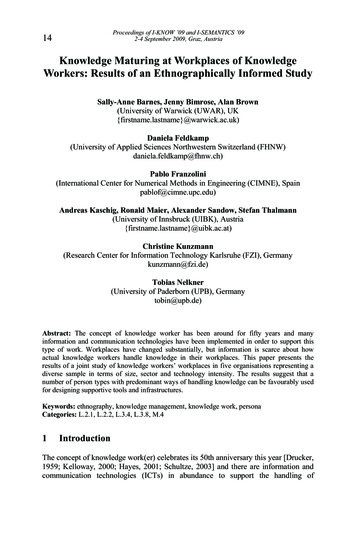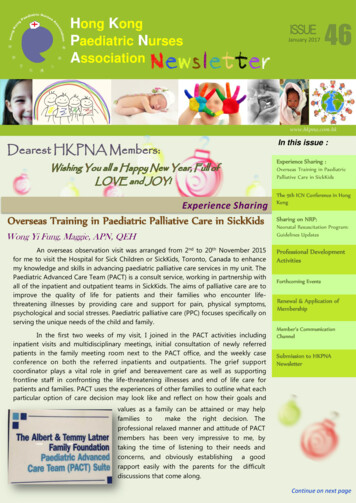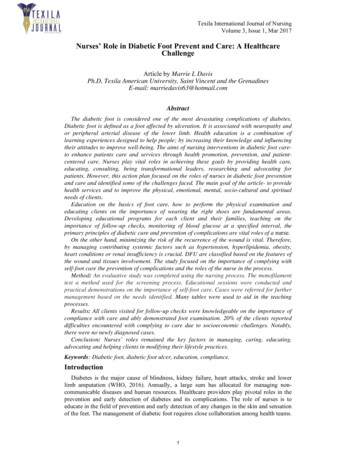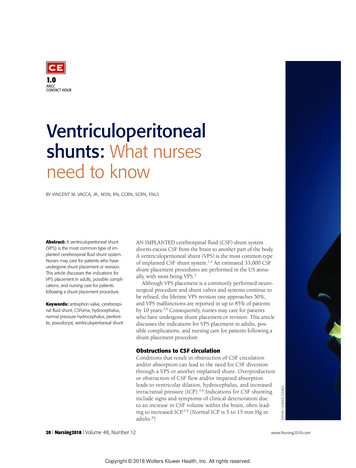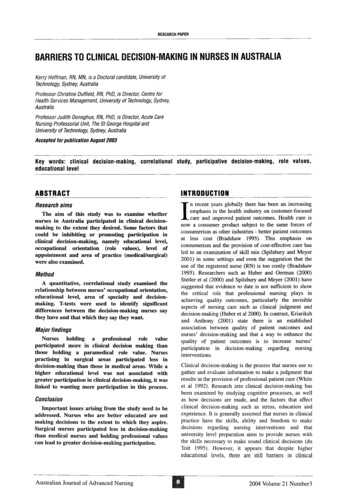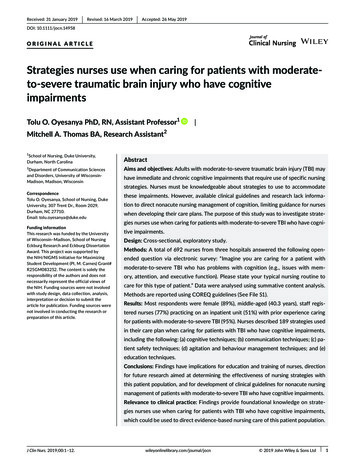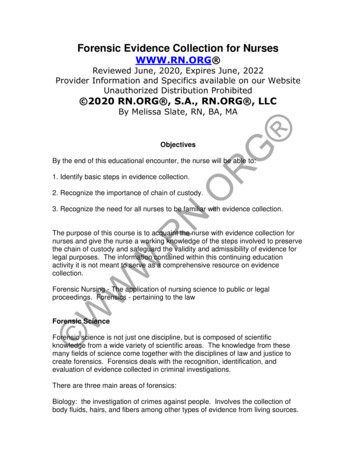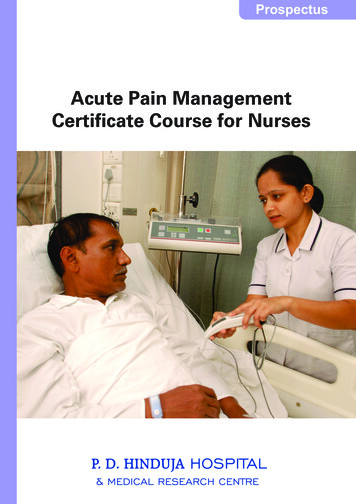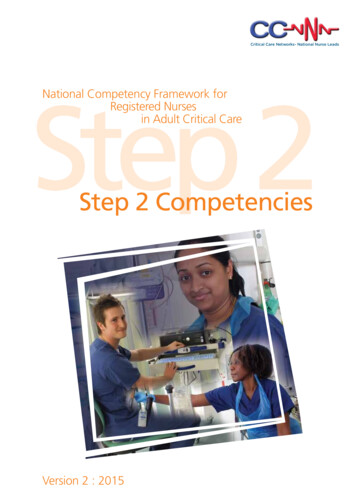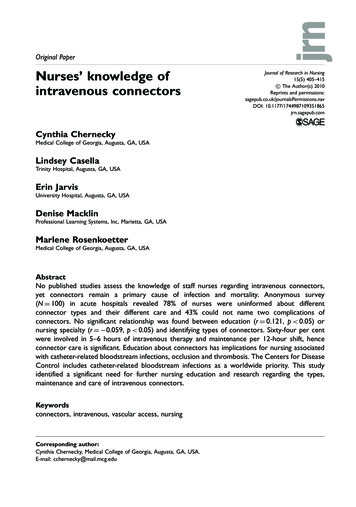
Transcription
Original PaperNurses’ knowledge ofintravenous connectorsJournal of Research in Nursing15(5) 405–415! The Author(s) 2010Reprints and OI: 10.1177/1744987109351865jrn.sagepub.comCynthia CherneckyMedical College of Georgia, Augusta, GA, USALindsey CasellaTrinity Hospital, Augusta, GA, USAErin JarvisUniversity Hospital, Augusta, GA, USADenise MacklinProfessional Learning Systems, Inc, Marietta, GA, USAMarlene RosenkoetterMedical College of Georgia, Augusta, GA, USAAbstractNo published studies assess the knowledge of staff nurses regarding intravenous connectors,yet connectors remain a primary cause of infection and mortality. Anonymous survey(N ¼ 100) in acute hospitals revealed 78% of nurses were uninformed about differentconnector types and their different care and 43% could not name two complications ofconnectors. No significant relationship was found between education (r ¼ 0.121, p 0.05) ornursing specialty (r ¼ 0.059, p 0.05) and identifying types of connectors. Sixty-four per centwere involved in 5–6 hours of intravenous therapy and maintenance per 12-hour shift, henceconnector care is significant. Education about connectors has implications for nursing associatedwith catheter-related bloodstream infections, occlusion and thrombosis. The Centers for DiseaseControl includes catheter-related bloodstream infections as a worldwide priority. This studyidentified a significant need for further nursing education and research regarding the types,maintenance and care of intravenous connectors.Keywordsconnectors, intravenous, vascular access, nursingCorresponding author:Cynthia Chernecky, Medical College of Georgia, Augusta, GA, USA.E-mail: cchernecky@mail.mcg.edu
406Journal of Research in Nursing 15(5)IntroductionThere is confusion among staff nurses about the different fundamental types of intravenous(IV) connectors used in caring for patients with vascular access. An electronic review of theliterature using the terms ‘vascular access’ and ‘connectors’ yielded one article fromMEDLINE and 34 from CINHAL in the years 1996 to July 2009. Most of the articleswere not research and spoke of either animal models, legal aspects (Scales, 2009) or sideeffects such as infection, air embolism and occlusion. There are two large studies, in theUnited Kingdom and Canada, that reveal problems with systems, equipment and protocolsand their importance to avoiding errors (Baxter Healthcare, 2007; National Audit Office,2005) and several professional organisations worldwide produce standards of care forintravenous and vascular access. These organisations include the Association forProfessionals in Infection Control and Epidemiology, Inc. (USA), Centers for DiseaseControl (USA), Evidence Based Practice in Infection Control (UK), Infusion NursesSociety (USA), Oncology Nursing Society (USA), Royal College of Nursing (UK), andVascular Access Society (The Netherlands). However, there were no studies that assessednursing knowledge of intravenous connectors. Hence, there is a large gap in the scientificliterature with regard to nursing knowledge, care and maintenance of connectors. Mostliterature is manufacturer devised and/or driven. There are three classifications of fluiddisplacement connectors and they are referred to as positive, negative and zero (formerlycalled neutral). Until now, no research studies have been initiated related to knowledge ofstaff nurses regarding connectors.Review of literatureThe intravenous connector is the gatekeeper of the intraluminal fluid pathway and is used inhospital as well as community settings (O’Hanlon et al., 2008). Care and maintenance of IVconnectors has been shown to be related to catheter occlusions and catheter-relatedbloodstream infections (Jarvis et al., 2005; Maragakis et al., 2006; Rupp et al., 2007).Proper care and maintenance of an intravenous connector (Casey et al., 2003; Doughertyand Watson, 2008; Macklin and Chernecky, 2004; Weinstein, 2007) is foremost to successfulpatient outcomes including the avoidance of occlusion, bloodstream infections andthrombus formation (Gallieni et al., 2008). These issues are important to patients andclinicians because there are related to mortality and tragic patient care errors haveoccurred (Simmons, 2006). Education is one major tool that can help eliminate problemsand increase positive outcomes.Needlefree IV connectors first entered the healthcare system in 1991. Design focused onsimple needlefree connection to reduce the rate of needlestick injuries to healthcare workers(Casey and Elliott, 2007). The first design was what is referred to as split septum. It allows ablunt cannula to connect by entering an existing slit. By the mid 1990s the design hadadvanced to allow direct luer connection without the added cannula. All of the variousconnectors had associated reflux with disconnection. This reflux resulted in increasedcatheter occlusion (Casella and Jarvis, 2007). With every disconnection fibrin layers builtup on the inner surface of the intraluminal fluid pathway which led to partial or totalocclusion (Rummel et al., 2001). To resolve the occlusion problem the positive pressureconnector entered the market in the late 1990s. This design moved the reflux fromdisconnection to connection. With connection a negative pressure occurs and then withdisconnection the pressure is released with a final push. This final push is designed to
Chernecky et al.407clear the catheter. Reduction in occlusion rates with the use of a positive pressure connectorhas been irregularly reported in the literature (Schilling et al., 2006). However, theintraluminal fluid pathway continues to experience the on-going surface conditioning offibrin caused by reflux. By the year 2000 positive pressure connector designs had beenassociated with an increase in catheter-related bloodstream infections (CR-BSIs) (Caseyet al., 2003; Marschall et al., 2008). In 2004 an intraluminal protection system entered themarket. It has zero reflux with connection or disconnection. Recent evidence reveals thatocclusions and CR-BSIs occur less frequently using a zero fluid displacement connectordesign (Caillouet, 2008).To prevent the re-entry of blood associated with negative IV connectors, the nurse duringdisconnection is required to apply pressure to the syringe barrel, close the catheter clamp andthen remove the syringe. In addition, when the nurse initiates a procedure she must insert thesyringe into the connector, put pressure on the syringe barrel and then open the clamp,otherwise the reflux that was minimised with disconnection will occur when the clamp isopened. The clamping sequence with positive pressure connectors is just the opposite.In order for the negative pressure to occur the clamp must be open with connection andnot clamped until after disconnection. If the clamping sequence used with negative systemconnectors is used with a positive pressure connector it prevents the final disconnection pushand over time can lead to suboptimal connector action. The zero fluid displacement designrequires no special clamping sequence.Knowing whether a positive or negative pressure system is being used is important. Thereare institutions that have several different IV connectors available for use by nurses andhealthcare personnel. Also, the use of ‘pulled’ nurses or agency nurses can make appropriatecare difficult and inconsistent. Occluded central venous access devices (CVADs) can cause anincrease in the use of thrombolytics and cost for patients and the institution, as well as adelay in treatment, and a decrease in patient satisfaction.Occlusions are also associated with increased CR-BSI. Micro-organisms, especiallyStaphylococcus aureus and Staphylococcus epidermidis, the two most commonmicro-organisms associated with CR-BSIs (Gallieni et al., 2008), adhere to fibrin. Theintraluminal protection provided by the IV connector with zero fluid displacement hasmade a recent positive impact on complication reduction but will not be discussed in thisarticle as its use was not widespread during the implementation of this study.The problem of CR-BSI is well defined by the Centers for Disease Control & Preventions(CDC) in relation to devices with connectors (O’Grady et al., 2002). Patients with long-termvascular access devices and those who are immunosuppressed are at increased risk foracquiring CR-BSIs, also called catheter-associated bloodstream infections (CA-BSIs), bymicrobes that frequently gain access through an IV connector septum (Menyhay andMaki, 2006). The cost of CR-BSIs has been calculated to be approximately 24,111 or 40,000 per episode (Rello et al., 2000; Soufir et al., 1999), making it a relevant cost issue.Recent research studies have begun to explore the use of antiseptic caps (Menyhay andMaki, 2006), external coated catheters (Bassetti et al., 2001) and disinfectable, needlefreeconnectors (Yébenes et al., 2004) to reduce CR-BSIs. Several studies reveal that specificconnectors increase blood stream infections (Field et al., 2007; Karchmer et al., 2005;Rosenthal 2006; Rupp et al., 2007).In general, to prevent catheter-related complications, patient care relies completely onnurses appropriately swabbing prior to access, with the intervention based on specific devicetype, and flushing after usage. The purpose of flushing is to clean the intraluminal surface of
408Journal of Research in Nursing 15(5)fibrin and prevent surface conditioning. One flushing option is using a pulsatile (push–pause)method creating turbulent flow (Dougherty, 2000).PurposeTwo main purposes of this study were to describe the current nursing knowledge regardingconnectors and identify the most effective teaching modalities for nurses to increasecompliance with maintenance of connectors.Theoretical frameworkOrem’s Self-Care Deficit Nursing Theory (Orem, 1995) was the framework for this study.According to this theory nurses use their specialised capabilities to create helping systems.In order to be helpful the nurse must understand the differences and similarities betweenconnectors. Once the nurse has this knowledge she/he can use it in a wholly compensatorysystem of helping patients who have an existent or potential problem with self-care deficit ofvascular access where use of a connector is employed.Definition of TermsIV connector ¼ device that connects to the IV catheter hub and allows needlefree access tothe catheter; reflux ¼ blood movement into the catheter as a result of connection to ordisconnection from the IV connector; negative IV connector ¼ movement of blood intothe catheter with disconnection; positive IV connector ¼ movement of blood into thecatheter with connection; zero fluid displacement IV connector ¼ no movement of bloodinto the catheter with either connection or disconnection.MethodologyAn anonymous questionnaire (Table 1) to collect data on nursing knowledge of IVconnector devices, designed by the principal investigators, was distributed to intensivecare, medical-surgical, and specialty units within one community and one tertiaryhospital in the south-eastern United States. A 16-item self-developed questionnairerelated to connectors was reviewed by an expert panel of advanced practice nursesin research, oncology, and vascular access. A cover letter was attached to eachanonymous questionnaire stating the purpose of the study, that this study used a nonidentifier method of gathering data, the questionnaire could only be filled out once byeach nurse, that the study was voluntary, and the need for subjects to be Englishspeaking, able to write English, be 21 years or older and a RN or LPN. A lockedsurvey collection box was posted at nursing stations at each hospital. Thequestionnaires were returned to this central location on the nursing units and collectedby the principal investigators during the timeframe of one week. The subjects were madeaware of this survey by verbal announcements at report time and during unit meetings.The survey included questions concerning the nurse’s background, their currentknowledge of connectors, and ways to improve or deliver education to the nursingstaff. The nursing staff who completed the questionnaire consisted of registered andlicensed practical nurses. The surveys were collected and the data were recorded and
Chernecky et al.409Table 1. Nursing knowledge questionnaire about IV connector devicesQUESTIONNAIRE1 What is your highest level of nursing education?A) LPN/LVN B) Associate C) Diploma D) BachelorE) MasterF) Doctorate2 Which shift is the primary shift you work?A) Day (7 a.m.–3 p.m.) B) Day–Evening (7 a.m.–7 p.m.) C) Evening (3 p.m.–11 p.m.)D) Evening–Night (7 p.m.–7 a.m.) E) Night (11 p.m.–7 a.m.)3 What is your time commitment for your primary position at the current facility?A) Part-time B) Full-time C) PRN4 What is your area of nursing specialty?A) Critical Care B) Telemetry C) Medical-SurgicalD) Oncology E) IV Therapy F) Other5 How many hours during your shift are you involved with IV therapy (infusionand maintenance)?A) 0 hrs B) 1–2 hrs C) 3–4 hrs D) 5–6 hrs.6 Have you been educated within the last year on your institution’s policy in regards to the use of IVconnectors?A) Yes B) No7 What is the primary incentive that would make you want to learn more about IV connectors?A) money B) time off C) flexible scheduleD) availability of resources E) other8 What do you feel is the most effective method in educating the staff on your unit about IV connectors?A) posters B) handouts C) e-mailD) hands-on demonstration E) staff meeting F) computer based/online trainingG) other9 Please rate how supportive your manager is of staff education in regards to daily nursing care.12345Not SupportiveOccasionallyVery SupportiveSupportive10 Prior to entering this study, did you know there are four different types of IV connectors (split septum,standard swabbable luer, positive pressure, zero) that can be connected to the hub of an IV line?A) Yes B) No11 Do you believe that all four different types of IV connectors (split septum, standard swabbable luer,positive pressure, zero) are maintained the same way?A) Yes B) No12 Please write which type of IV connector (not the name brand) you use in your facility.13 Please name two complications related to improper maintenance of these IV connectors.1. 2.14 What percentage of the time do you follow your institution’s policy regarding nursing care andmaintenance of these IV connectors?A) 0–25% B) 26%–50% C) 51%–75% D) 76%–100%(continued)
410Journal of Research in Nursing 15(5)Table 1. ContinuedQUESTIONNAIRE15 How important do you believe changing and maintaining IV connectors according to policy has to dowith decreasing blood stream infection?12345Not ImportantImportantVery Important16 Do you clean each IV connector with alcohol prior to each accessing?A) Yes B) Noanalysed by the principal investigator and sub-investigators. Once the data were recordedand analysed, all surveys were shredded.This research protocol met criteria for exempt review. This study was reviewed by theHuman Assurance Committee at the Medical College of Georgia and both hospital sites.There was no informed consent associated with this study since a non-identifierquestionnaire was used.SamplingThe convenience sample consisted of 100 volunteer nurse participants. Inclusion criteriaincluded: subjects of 21 years of age or older, women of child-bearing age were notexcluded, and all subjects were able to read, write and speak English. Exclusion criteriaincluded: subjects less than 21 years of age and subjects who were not able to read, writeor speak English.InstrumentationA self-developed 16-item questionnaire included items related to education level, shiftworked, full versus part-time status, area of specialty within nursing, number of hoursinvolved in IV therapy per shift, preferred methods of education, and IV connectors.ResultsData were entered based on the development of a research code book. Frequency andcorrelational data were analysed using SPSSß Inc. statistical software.The sample consisted of 98% registered nurses (6% Diploma, 44% ADN, 45% BSN, 5%MSN) and 2% licensed practical nurses. Most nurses (56%) worked the 7a.m.–7p.m. shift.Other shifts included 7a.m.–3p.m. (24%), 7p.m.–7a.m. (18%) and 11p.m.–7a.m. (2%).Seventy per cent were full-time, 15% part-time and 15% prn (pro re nata, as needed).Most nurses worked in critical care (41%) followed by telemetry (37%), medical-surgical(15%) and the IV Therapy Team (7%).Sixty-four per cent of nurses stated that they were involved in at least 5–6 hours ofintravenous therapy and maintenance per 12-hour shift with another 16% involved in 3–4hours per 12-hour shift. Eighty per cent had been educated in the last year on theinstitution’s IV policy, which contains general connector information.
Chernecky et al.411Education ds onDemonstrationStaff meetingsComputer basedOnline trainingMissing1.0%68.0%Figure 1. Education methods for connectorsPrimary learning incentives included availability of resources (41%), money (23%), other(22%), flexible scheduling (9%) and time off (5%). The most preferred method for educatingstaff about connector maintenance was overwhelmingly hands-on (68%). Other educationmethods included 3% for posters, 3% handouts, 2% computer-based training, 1% email and1% staff meeting education (Figure 1). There was no relationship between nursing specialtyand education method (Pearson’s r ¼ 0.000, p 0.05). Managerial support for education wasranked as very supportive (50%) and mostly supportive (33%).When it came to identifying the type of IV connector used in the respective facility, 54 outof 85 subjects stated one of the four types (30 standard luer, 13 split septum, 10 positive, and1 zero) with 31 naming connector types that do not exist. There were 15 subjects who gave noanswer. The researchers have no way of determining whether the subjects who named one ofthe four types answered correctly but the researchers do know that zero connectors were notused at either site and that split septum connectors were not used at one site. There was nosignificant relationship between education and identifying types of connectors (r ¼ 0.121,p 0.05) or nursing specialty and identifying types of connectors (r ¼ 0.059, p 0.05).Naming two complications related to improper maintenance of connectors revealed 21%clots, 8% loose site and 5% each for leaks and occlusions. There were 43% who did notanswer this question. There were 85% of staff who felt they followed their institution’s policyregarding care and maintenance of connectors 76–100% of the time. A vast majority (92%)believed maintenance of connectors had to do with decreasing bloodstream infectionsthough there was no significant relationship between nursing specialty and decreasedbloodstream infections (r ¼ 0.128, p 0.05). The majority of nurses (95%) stated theycleansed the connector with alcohol prior to accessing the IV line, which was policy, butwe do not now if it was effective or efficient.During the study 78% of nurses reported that they were not aware that there were fourcategory types of intravenous connectors (split-septum negative pressure, standard swabable
412Journal of Research in Nursing 15(5)40Count3020100LPN/LVNAssocitate DiplomadegreeFour types ducationFigure 2. Question 10: did you know there were four types of intained eEducationFigure 3. Question 11: are all four types of connectors maintained the same way?luer negative pressure, positive pressure, and zero) and 30% believed all types weremaintained the same way (Figure 2). All five education levels of nurses (from LPN toMaster’s degree) reported that they did not know there were four category types ofconnectors (Figure 3). Education seemed to begin to make a difference at the Master’s
Professional Learning Systems, Inc, Marietta, GA, USA Marlene Rosenkoetter Medical College of Georgia, Augusta, GA, USA Abstract No published studies assess the knowledge of staff nurses regarding intravenous connectors, yet connectors remain a primary cause of infection and mortality. Anonymous survey
